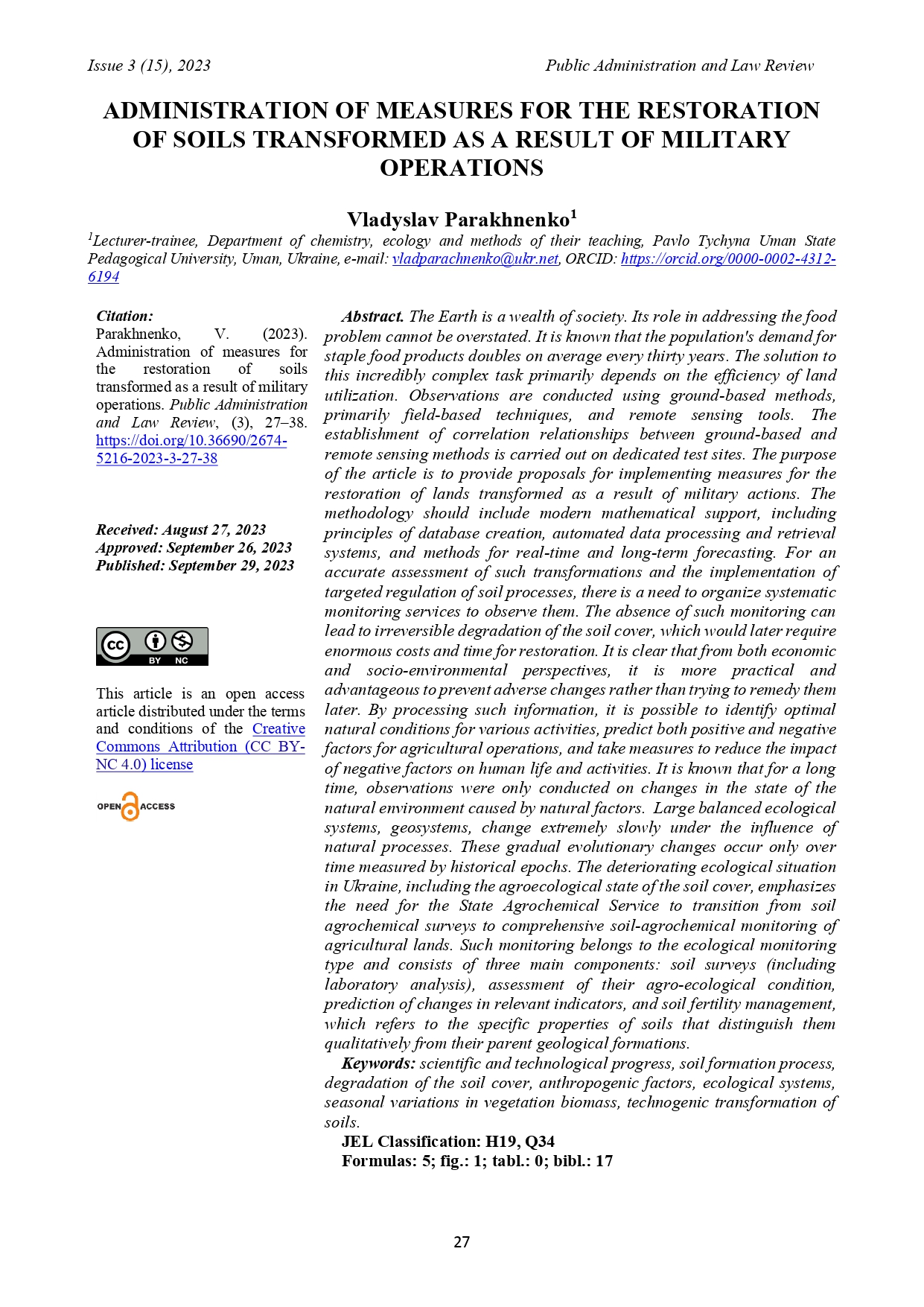ADMINISTRATION OF MEASURES FOR THE RESTORATION OF SOILS TRANSFORMED AS A RESULT OF MILITARY OPERATIONS
DOI:
https://doi.org/10.36690/2674-5216-2023-3-27-38Keywords:
scientific and technological progress, soil formation process, degradation of the soil cover, anthropogenic factors, ecological systems, seasonal variations in vegetation biomass, technogenic transformation of soils, administrationAbstract
The Earth is a wealth of society. Its role in addressing the food problem cannot be overstated. It is known that the population's demand for staple food products doubles on average every thirty years. Therefore, in order to provide enough food for all the people living in the years 2010-2020, the productivity of agriculture needs to be doubled. The solution to this incredibly complex task primarily depends on the efficiency of land utilization. Observations are conducted using ground-based methods, primarily field-based techniques, and remote sensing tools. The establishment of correlation relationships between ground-based and remote sensing methods is carried out on dedicated test sites. The purpose of the article is to provide proposals for implementing measures for the restoration of lands transformed as a result of military actions. The methodology should include modern mathematical support, including principles of database creation, automated data processing and retrieval systems, and methods for real-time and long-term forecasting. For an accurate assessment of such transformations and the implementation of targeted regulation of soil processes, there is a need to organize systematic monitoring services to observe them. The absence of such monitoring can lead to irreversible degradation of the soil cover, which would later require enormous costs and time for restoration. It is clear that from both economic and socio-environmental perspectives, it is more practical and advantageous to prevent adverse changes rather than trying to remedy them later. By processing such information, it is possible to identify optimal natural conditions for various activities, predict both positive and negative factors for agricultural operations, and take measures to reduce the impact of negative factors on human life and activities. It is known that for a long time, observations were only conducted on changes in the state of the natural environment caused by natural factors. Indeed, the state of the biosphere changes under the influence of both natural and anthropogenic factors. However, there is a significant difference in the outcomes of these influences: the state of the biosphere, which constantly changes due to natural causes, usually returns to its previous state. Large balanced ecological systems, geosystems, change extremely slowly under the influence of natural processes. These gradual evolutionary changes occur only over time measured by historical epochs. The deteriorating ecological situation in Ukraine, including the agroecological state of the soil cover, emphasizes the need for the State Agrochemical Service to transition from soil agrochemical surveys to comprehensive soil-agrochemical monitoring of agricultural lands. Such monitoring belongs to the ecological monitoring type and consists of three main components: soil surveys (including laboratory analysis), assessment of their agro-ecological condition, prediction of changes in relevant indicators, and soil fertility management, which refers to the specific properties of soils that distinguish them qualitatively from their parent geological formations.
Downloads
References
Sozinov, O.O. & Pristera B.S. (1994). Methodology of comprehensive soil-agrochemical monitoring of agricultural lands in Ukraine. Kyiv, p. 56, 101.
Medvedev V.V. (1992). Soil fertility. Monitoring and management. Kyiv, "Urozhai" publishing, p. 3, 153, 232.
Lapiga I.V. (2018). Radioecology: laboratory manual. Kyiv: NPU named after M.P. Dragomanov, 53 p.
Klymenko M.O., Klymenko O.M. & Klymenko L.V. (2020). K49 Radioecology: textbook. Rivne: NUVGP, 304 p.
Hamaliy I.P. (2002). Substantiation of content and organization of radioecological monitoring of agrolandscapes with patchy radioactive contamination. Regional ecological problems: Collection of scientific papers. Kyiv, Obrii, pp. 126-128.
Grodzinsky D.M. (2000). Radiobiology: Textbook. Kyiv, Lybid, 448 p.
Konstantinov M.P. & Zhurbenko O.A. (2003). Radiation safety: Educational manual. Sumy: VTD "Universitetska knyha". 151 p.
Hamaliy I.P. (2002). Substantiation of content and organization of radioecological monitoring of agrolandscapes with patchy radioactive contamination. Regional ecological problems: Collection of scientific papers. Kyiv: Obrii. pp. 126-128.
Grozdinsky D.M. (2000). Radiobiology: Textbook. Kyiv, Lybid, 448 p.
Hukalova I.V. (2002). Ecological and social priorities for the development of radiation-contaminated regions of Ukraine. Regional ecological problems: Collection of scientific papers. Kyiv: Obrii. pp. 274-277.
Yegorova-Gudkova, T. (2022). Mixology as basis of food security. Economics, Finance and Management Review, (1), 18–24. https://doi.org/10.36690/2674-5208-2022-1-18.
Mihus, I.& Denysenko, M. (2021). Methodical Approach to Assessing Food Safety of Ukraine. Proceedings of the 2nd International Scientific and Practical Conference “Modern Management Trends and the Digital Economy: from Regional Development to Global Economic Growth” (MTDE 2020) Retrieved from:https://doi.org/10.2991/aebmr.k.210320.001.
Rumyk, I. (2021). Modeling the impact of economic indicators on food security. Economics, Finance and Management Review, (2), 4–13. https://doi.org/10.36690/2674-5208-2021-2-4.
Shcherbyna, S. (2022). Management of food provision for vulnerable layers of the Ukraine’s population. Economics, Finance and Management Review, (1), 25–33. https://doi.org/10.36690/2674-5208-2022-1-25.
Karpa, M., Akimov, O., & Kitsak, T. (2022). Problems of stabilization of the system of public administration under the conditions of decentralizational changes and martial law in Ukraine. Public Administration and Law Review, (3), 24–31. https://doi.org/10.36690/2674-5216-2022-3-24.
Farouq Ahmad Faleh Alazzam, & Rasha Bashar Ismail Al sabbagh. (2021). The importance of non-tariff barriers in regulating international trade relations. Public Administration and Law Review, (1), 92–104. https://doi.org/10.36690/2674-5216-2021-1-92.
Al Azzam, F.A.F., Alshunnaq, M.F.N., Lesko, N., Lukianova, H., Smotrych, D. (2022). The main threats in the practice of a lawyer to ensure environmental safety in the context of COVID-19. International Journal of Safety and Security Engineering, Vol. 12, No. 3, pp. 387-393. https://doi.org/10.18280/ijsse.120313.

Downloads
Published
How to Cite
Issue
Section
License

This work is licensed under a Creative Commons Attribution-NoDerivatives 4.0 International License.





